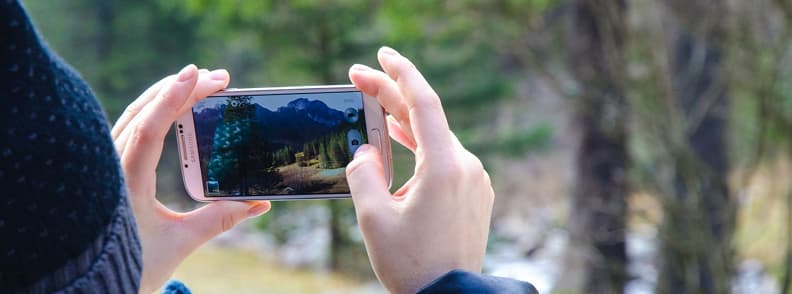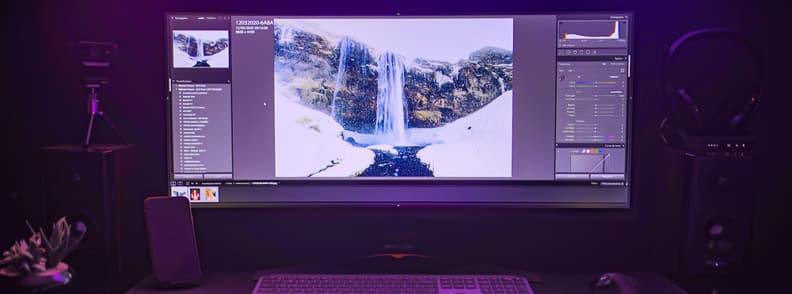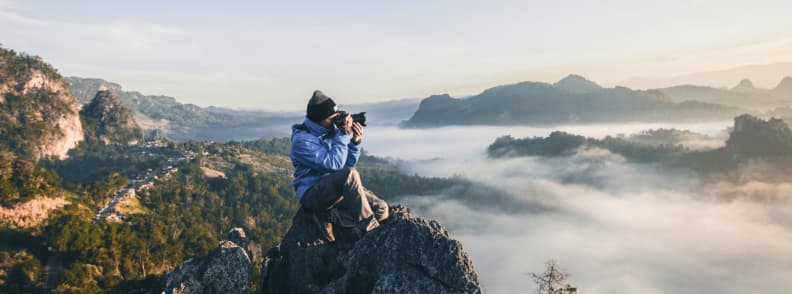Getting ready for another adventurous journey? Then make sure to read the 8 best landscape photography tips below. They will help you improve your landscape photography and shoot breathtaking nature pictures to show off to your friends and family. Now let’s get started!
1. Bring a suitable camera
For any kind of trip, we recommend pocket-sized cameras, as they won’t take up much space and will be easy to carry wherever you go. By the way, over the past few years, GoPro cameras have become popular among seasoned travelers, and it’s obvious why. They are tiny, powerful, and affordable. This type of camera is mainly used for recording videos, but shooting pictures is also possible. Even though GoPro cameras are not suitable for taking portraits, they will let you easily capture landscape scenes.
But apart from the size of the gear, it’s important to consider the focal length it offers – the longer, the better. While traveling, you will often need to zoom in, especially for shooting pictures of animals. Also, you’ll need a wide lens on the camera that can handle that boost in ISO in case you would like to capture massive landscapes in low light.
Last but not least, remember to take spare batteries, memory cards, and lenses as well – you might not find them in the country you visit. But finding a powerful camera is not enough, you should also take care of it. If you don’t practice good camera lens cleaning techniques, you may end up spending your time trying to get rid of dust particles, smudges, and flare in post-production. Besides, if your camera is not waterproof, it will be wise to order a waterproof case to protect it from rain and moisture. With a reliable bag on your gear, you can also take surreal shots underwater. There are also lens hoods for those who don’t want to cover the whole camera.

2. Shoot in RAW
The RAW file format is the most popular type among professional photographers. RAW files are larger, but that is the only disadvantage they have. They capture more details, and the quality of your landscape photography will be much higher than in JPEG or PNG files. Therefore, RAW images give you more flexibility for photo editing, e.g., editing highlights and white balance, color correction, and so on.
There are also cameras that allow you to shoot in both RAW and JPEG. Even if you just intend to use the JPG format now, we recommend shooting in both. Later, you might want to tweak the original RAW photos as your photography skills develop. However, some modern smartphones usually have the option to shoot in RAW too, so this tip doesn’t just apply to DSLR cameras.
3. Find unusual angles
If you google nature photographs, you’ll notice that they all look pretty much the same, especially those that are taken in a well-known place, such as Niagara Falls or the Grand Canyon. To take truly unique pictures, look for unusual angles. Even when shooting popular destinations, you can still show the places from a new perspective. For instance, if there’s a lake, take advantage of it – water can reflect the sky, mountains, and forest in a very beautiful way, so the photo will definitely stand out.
However, the horizon of the landscape is crucial – be sure to get the picture horizon straight. Most cameras offer built-in grids, such as the thirds grid, so you can turn it on to make sure the horizon in your shots is correct.

4. Mind the composition
Composition is one of the key elements that make a good photograph. Composition rules are especially important to follow when capturing picturesque landscapes. You can begin with the Rule of Thirds. According to it, the best part of the image should be placed on one of the sides of the picture rather than in the center. When the object is placed in the center, the photo looks static – this kind of composition is used more frequently in portrait photography. Another way to make a photo eye-catching is by using leading lines, they make the viewer follow the lines and explore the picture.
5. Bring along a tripod
While traveling, any tiny movement in your hands can cause blurry, unsharp images. But with a tripod at hand, you can forget about that problem. When you attach your camera or phone to the tripod, it doesn’t shake or move anymore, so your images will look sharp and detailed.
To carry as little as possible, you’ll need to get the lightest, most stable tripod. With the rise of the blogging industry, tripods have become more affordable, and now the market offers tripods in a range of sizes – you can order a very small one that will be more suitable for traveling. Travel tripods will be best for landscape, nature, and travel-related photography.

6. Enhance photos in post-production
You never know when you’ll encounter a beautiful scene while traveling, so you will often have just a couple of seconds to turn on your camera and take the shot. In such a rush, your photos might turn out not as stunning as the scene itself. To get the most out of your nature pictures, perfect them in landscape photo editing software. In post-production, you can give the colors a bit of a boost, crop your photos for posting them online, remove unwanted objects, play with contrast and sharpness to improve the quality, straighten the horizon in your shots, and much more.
7. Take advantage of natural light
In landscape photography, you can take amazing shots in natural light. There is no need to use any additional equipment like a flashlight unless you shoot pictures at night. However, it’s a good idea to plan your shooting in advance – the time of day you choose can dramatically affect the photos. For example, the golden hour, the period within the hour just after sunrise or the hour before the sun sets, is one of the best options – such images have a dreamy soft look and will never leave you disappointed. Photos taken at noon, on the contrary, will look too tense due to the harsh sunlight.

8. Backup your nature photos
Memories from your trips are priceless, and you can’t bring those times back. So if you don’t want to lose your photographs, make sure to backup all of them. You can upload the files to cloud storage like Dropbox, Microsoft OneDrive, or Google Drive. However, there are limits to how much you can save for free, so you’ll need to purchase a paid subscription to expand the memory. But if you don’t want to put your privacy at risk, you can backup your landscape pictures to an external hard drive.
Ready to apply these landscape photography tips?
So are you ready to capture the best photos of your life? As long as you follow the tips from this article, we’re sure, your nature pictures will look like works of art. Your landscape pictures can give a unique sense of place, and you will have images you can look proudly back on in years to come. So go ahead and put our tips into practice on your upcoming trip right away.

Introducing Mirela Letailleur, a renowned Romanian travel blogger residing in the picturesque South of France. With an unwavering passion for capturing the essence of European landscapes, Mirela has established herself as an authoritative voice in the realm of affordable travel. Through her captivating articles on The Travel Bunny travel blog, she unveils the secrets to explore Europe without breaking the bank.
Mirela’s expertise extends beyond budget-friendly adventures. Her profound knowledge of landscape photography tips sets her apart as the ultimate guide for aspiring photographers. Her unique free travel guides not only help you navigate Europe’s hidden gems but also equip you with invaluable tips and tricks to master the art of capturing breathtaking outdoor scenes. Whether it’s composing the perfect shot, harnessing natural lighting, or enhancing images through editing, Mirela’s insights will elevate your photography skills to new heights.
After learning the best landscape photography tips, check out these travel blog posts
5 creative ideas on how to use your old travel photos
How to make solo travel videos for YouTube
Travel slideshows: The best way to display your adventures

